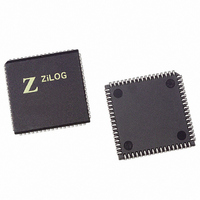Z16C3516VSG Zilog, Z16C3516VSG Datasheet - Page 25

Z16C3516VSG
Manufacturer Part Number
Z16C3516VSG
Description
IC 16MHZ Z8500 CMOS ISCC 68-PLCC
Manufacturer
Zilog
Series
IUSC™r
Specifications of Z16C3516VSG
Controller Type
Serial Communications Controller (SCC)
Interface
USB
Voltage - Supply
4.75 V ~ 5.25 V
Current - Supply
50mA
Operating Temperature
0°C ~ 70°C
Mounting Type
Surface Mount
Package / Case
68-LCC (J-Lead)
Lead Free Status / RoHS Status
Lead free / RoHS Compliant
Other names
269-4690-5
Z16C3516VSG
Z16C3516VSG
Available stocks
Company
Part Number
Manufacturer
Quantity
Price
Company:
Part Number:
Z16C3516VSG
Manufacturer:
INTEL
Quantity:
6 219
- Current page: 25 of 268
- Download datasheet (3Mb)
UM011001-0601
3.4 DATA ENCODING/DECODING
The ISCC provides four different data encoding methods,
selected by bits D6 and D5 in WR10. An example of these
four encoding methods is shown in Figure 3-3. Any
encoding method may be used in any X1 mode in the
In NRZ, encoding a “1” is represented by a HIGH level and
a “0” is represented by a LOW level. In this encoding meth-
od, only a minimal amount of clocking information is avail-
able in the data stream in the form of transitions on bit-cell
boundaries. In an arbitrary data pattern, this may not be suf-
ficient to generate a clock for the data from the data itself.
In NRZI, encoding a “1” is represented by no change in the
level and a “0” is represented by a change in the level. As
in NRZ, only a minimal amount of clocking information is
available in the data stream, in the form of transitions on
bit cell boundaries. In an arbitrary data pattern this may not
be sufficient to generate a clock for the data from the data
itself. In the case of SDLC, where the number of consecu-
tive “1s” in the data stream is limited, a minimum number
of transitions to generate a clock are guaranteed.
In FM1 encoding, also known as biphase mark, a transition
is present on every bit cell boundary, and an addition tran-
sition may be present in the middle of the bit cell. In FM1 a
“0” is sent as no transition in the center of the bit cell and a
“1” is sent as a transition in the center of the bit cell. FM1
encoded data contains sufficient information to recover a
clock from the data.
(Biphase Space)
MANCHESTER
(Biphase Mark)
DATA
NRZI
NRZ
FM1
FM0
1
1
Figure 3-3. Data Encoding Methods
0
0
1
ISCC, asynchronous or synchronous. The data encoding
selected is active even though the transmitter or receiver
may be idling or disabled. The data encoding methods are
shown in Figure 3-3.
In FM0 encoding, also known as biphase space, a transi-
tion is present on every bit cell boundary and an additional
transition may be present in the middle of the bit cell. In
FM0, a “1” is sent as no transition in the center of the bit
cell and a “0” is sent as a transition in the center of the bit
cell. FM0 encoded data contains sufficient information to
recover a clock from the data.
Manchester encoding, which is not directly supported, al-
ways produces a transition at the center of the bit cell. If
the transition is Low to High, the bit is “0.” If the transition
is High to Low, the bit is “1.” ISCC can be used to decode
Manchester (biphase level) data by using the DPLL in the
FM mode and programming the receiver for NRZ data.
(See section 3.5.3.)
The data encoding method should be selected in the initial-
ization procedure before the transmitter and receiver are
enabled, but no other restrictions apply. Note, in Figure 3-
3, that in NRZ and NRZI the receiver samples the data only
on one edge. However, in FM1 and FM0 the receiver sam-
ples the data on both edges. Also, as shown in Figure 6-4,
the transmitter defines bit cell boundaries by one edge in
all cases and uses the other edge in FM1 and FM0 to cre-
ate the mid-bit transition.
0
ISCC™ DMA and Ancillary Support Circuitry
Z16C35ISCC™ User’s Manual
Bit Cell Level:
High = 1
Low = 0
No Change = 1
Change = 0
3-5
3
Related parts for Z16C3516VSG
Image
Part Number
Description
Manufacturer
Datasheet
Request
R

Part Number:
Description:
CMOS ISCC INTEGRATED SERIAL COMMUNICATIONS CONTROLLER
Manufacturer:
ZILOG [Zilog, Inc.]
Datasheet:

Part Number:
Description:
Communication Controllers, ZILOG INTELLIGENT PERIPHERAL CONTROLLER (ZIP)
Manufacturer:
Zilog, Inc.
Datasheet:

Part Number:
Description:
KIT DEV FOR Z8 ENCORE 16K TO 64K
Manufacturer:
Zilog
Datasheet:

Part Number:
Description:
KIT DEV Z8 ENCORE XP 28-PIN
Manufacturer:
Zilog
Datasheet:

Part Number:
Description:
DEV KIT FOR Z8 ENCORE 8K/4K
Manufacturer:
Zilog
Datasheet:

Part Number:
Description:
KIT DEV Z8 ENCORE XP 28-PIN
Manufacturer:
Zilog
Datasheet:

Part Number:
Description:
DEV KIT FOR Z8 ENCORE 4K TO 8K
Manufacturer:
Zilog
Datasheet:

Part Number:
Description:
CMOS Z8 microcontroller. ROM 16 Kbytes, RAM 256 bytes, speed 16 MHz, 32 lines I/O, 3.0V to 5.5V
Manufacturer:
Zilog, Inc.
Datasheet:

Part Number:
Description:
Low-cost microcontroller. 512 bytes ROM, 61 bytes RAM, 8 MHz
Manufacturer:
Zilog, Inc.
Datasheet:

Part Number:
Description:
Z8 4K OTP Microcontroller
Manufacturer:
Zilog, Inc.
Datasheet:

Part Number:
Description:
CMOS SUPER8 ROMLESS MCU
Manufacturer:
Zilog, Inc.
Datasheet:

Part Number:
Description:
SL1866 CMOSZ8 OTP Microcontroller
Manufacturer:
Zilog, Inc.
Datasheet:

Part Number:
Description:
SL1866 CMOSZ8 OTP Microcontroller
Manufacturer:
Zilog, Inc.
Datasheet:

Part Number:
Description:
OTP (KB) = 1, RAM = 125, Speed = 12, I/O = 14, 8-bit Timers = 2, Comm Interfaces Other Features = Por, LV Protect, Voltage = 4.5-5.5V
Manufacturer:
Zilog, Inc.
Datasheet:











